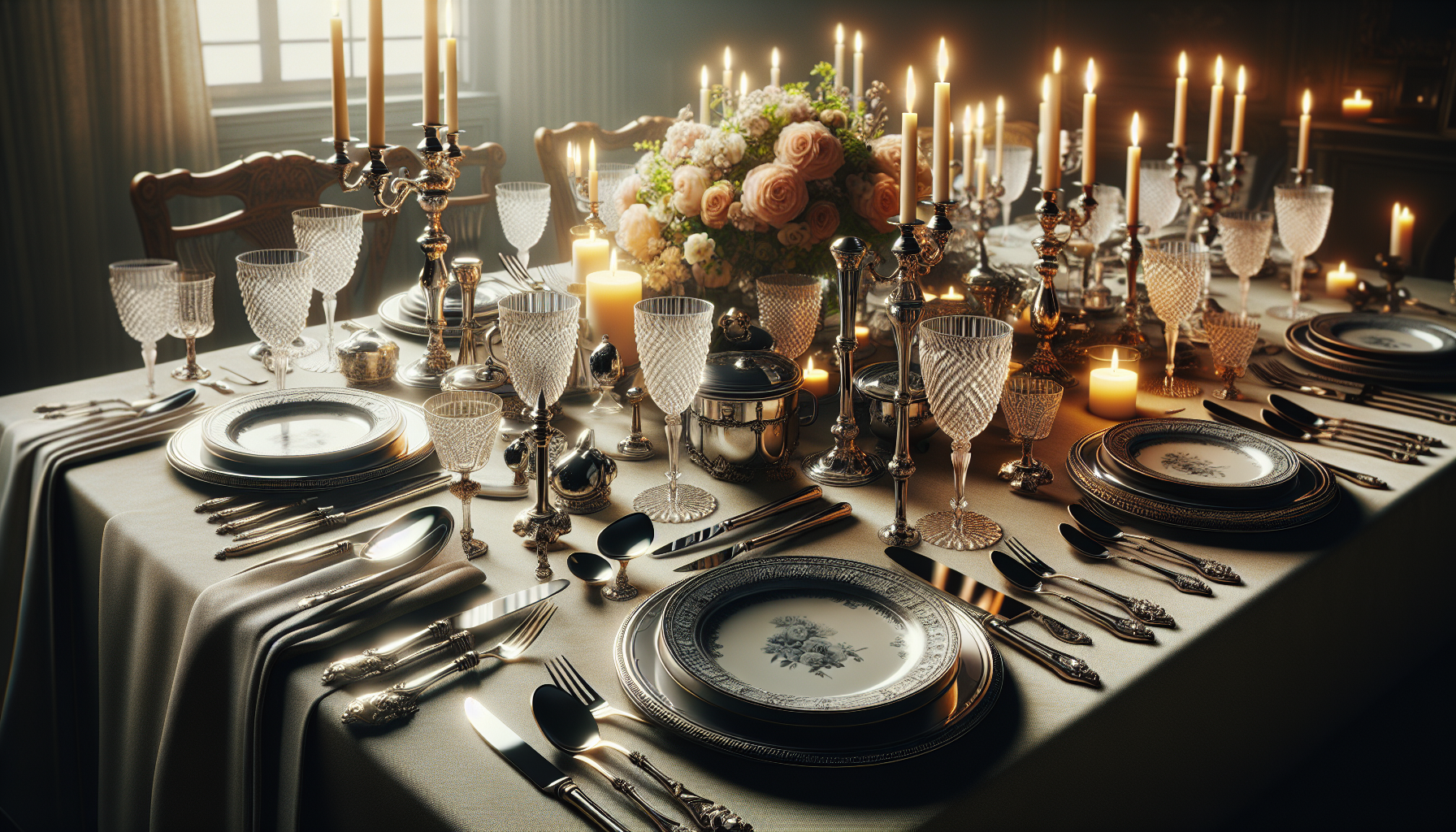There’s an undeniable magic that happens when friends and family gather around a beautifully set table, laughter intertwining with the clinking of glasses and the aromatic symphony of delicious dishes. The dinner party, an art form in its own right, is where culinary creativity meets conviviality. But while the menu often takes center stage, it’s the often-overlooked supporting cast of feasting tools and utensils that can truly elevate the dining experience from memorable to unforgettable. 🥂
In this ultimate guide to feasting tools and utensils for your next dinner party, we’re diving deep into the essentials that every host should consider. From selecting the perfect cutlery to choosing statement serveware that complements your culinary creations, these elements are as crucial to your event as the recipes you’ve been perfecting. After all, presentation is half the battle, and the right tools can make even the simplest dish look like a masterpiece. This isn’t just about aesthetics; it’s about creating an experience, setting a mood, and offering your guests an indulgence that tantalizes all the senses.
We’ll begin by exploring the essentials of cutlery, examining how the right forks, knives, and spoons can enhance not just the practicalities of eating but also the elegance of your table setting. Are you familiar with the difference between a dinner fork and a salad fork? Does your cutlery reflect the tone of your gathering, whether it’s a casual brunch or a formal soirée? We’ll unravel these mysteries and offer tips on selecting pieces that add a touch of sophistication and harmony to your table.
Next, we’ll delve into the world of serveware—the platters, bowls, and boards that carry your culinary creations from kitchen to table. Whether you’re serving a rustic charcuterie or a delicate pavlova, the right serveware can highlight the colors and textures of your dishes, making them even more inviting. We’ll guide you through choosing materials and styles that not only suit your theme but also withstand the demands of entertaining, ensuring that your pieces remain as timeless as your hosting.
Finally, we’ll discuss the importance of those special, sometimes whimsical, tools that add flair and functionality to your dinner party. Think elegant carafes for decanting wine, stunning cheese knives that become conversation starters, or unique salad tongs that make serving as enjoyable as savoring. These finishing touches, often overlooked, have the power to transform a meal into a memorable occasion, infusing your event with personality and charm. 🍽️
By the end of this guide, you’ll be equipped with the knowledge and inspiration to curate a dining experience that reflects your style and hospitality. Whether you’re a seasoned host or planning your first gathering, our insights will help you turn every meal into a celebration, where the tools and utensils you choose play a starring role. So, let’s set the table, ignite your imagination, and embark on a journey of culinary artistry and convivial delight.
Understanding the Importance of Choosing the Right Feasting Tools
When planning a dinner party, the spotlight often falls on the menu and décor. However, the utensils you choose can make or break the dining experience. From the weight and feel of a fork to the gleam of a polished spoon, every detail contributes to the ambiance and functionality of your event. Selecting the right tools not only enhances the meal but also adds a layer of sophistication that guests will appreciate and remember.
The psychology behind dining tools goes beyond mere functionality. Research shows that the aesthetics and ergonomics of cutlery can affect our perception of taste and enjoyment. A heavy, well-designed knife can make cutting into a juicy steak more satisfying, while a delicate dessert spoon can enhance the experience of a creamy mousse. Understanding these subtle influences can elevate your dinner party from a simple gathering to a memorable culinary experience.
To help you make informed choices, we delve into various types of dining tools, their historical significance, and the materials that define their quality. Whether you’re a seasoned host or a novice, knowing the intricacies of feasting tools will empower you to craft a meal that is as visually appealing as it is delicious.
Materials Matter: Choosing the Right Utensil Composition
The material of your dining tools plays a crucial role in their performance and longevity. Stainless steel remains a popular choice for its durability and resistance to tarnish. It’s no wonder that most households opt for stainless steel cutlery, given its low maintenance and sleek appearance. However, within the realm of feasting tools, there’s a world of materials that offer distinct advantages and aesthetic appeal.
For those seeking elegance, silver cutlery provides a timeless charm. Although it requires more care to prevent tarnishing, the warmth and luxury it brings to a table setting are unparalleled. On the other hand, wooden utensils add a rustic touch and are excellent for non-stick cookware due to their gentle surface. Bamboo, a sustainable option, is not only environmentally friendly but also naturally antimicrobial.
The following table provides a comparative overview of popular utensil materials:
| Material | Advantages | Disadvantages |
|---|---|---|
| Stainless Steel | Durable, rust-resistant, low maintenance | Can be heavy, not biodegradable |
| Silver | Elegant, enhances table settings | Requires polishing, more expensive |
| Wood | Gentle on cookware, rustic appeal | Can absorb flavors, requires care |
| Bamboo | Sustainable, antimicrobial | Limited designs, can be less durable |
For a visual understanding of how different materials affect the dining experience, watch this insightful video: The Art of Choosing Utensils – Dining Aesthetics from the channel Dining Aesthetics.
Types of Utensils: A Comprehensive Guide
Understanding the variety of utensils available can be overwhelming. However, each type of utensil has a specific role in dining and knowing their functions can enhance the dining experience for both the host and the guests. From the classic dinner fork to the elegant soup spoon, each piece serves a purpose.
Forks: The dinner fork is the most versatile and commonly used fork in any set. For more formal occasions, salad forks, with their shorter tines, are designed specifically for salads and delicate appetizers. Dessert forks, often smaller, are perfect for sweet treats. Seafood forks, with their slim profile, are ideal for extracting meat from shellfish.
Spoons: Soup spoons feature a round bowl, perfect for sipping broths and soups. Teaspoons, slightly smaller, are used for stirring tea and coffee. Dessert spoons, with their shallow bowls, are designed for soft desserts like puddings and custards. Grapefruit spoons, serrated at the edge, are specifically designed to scoop out citrus fruits with ease.
Knives: A dinner knife serves as a multipurpose tool for cutting most foods. Steak knives, with their serrated edges, are essential for meats. Butter knives, with their rounded tips, are used for spreading butter or soft spreads. Fish knives, with their flat and pointed shape, are crafted to gently lift fish fillets from bones.
Here’s a quick reference list for the types of utensils:
- Dinner Fork
- Salad Fork
- Dessert Fork
- Seafood Fork
- Soup Spoon
- Teaspoon
- Dessert Spoon
- Grapefruit Spoon
- Dinner Knife
- Steak Knife
- Butter Knife
- Fish Knife
As you explore these options, consider the specific needs of your menu and how each tool can contribute to the overall dining experience. Experimenting with different utensils can also be a fun way to express your style and creativity as a host.
Setting the Table: Creating a Cohesive Look
Once you’ve selected the perfect utensils, it’s time to focus on setting the table. A well-set table not only showcases your chosen tools but also enhances the meal’s presentation. Begin with a clean, pressed tablecloth or placemats that complement your dining room’s décor. The color scheme should harmonize with your chosen utensils and dinnerware.
Consider the placement of each piece carefully. Traditionally, forks are placed to the left of the plate, knives to the right, with blades facing inwards, and spoons to the right of the knives. For a formal setting, align the bottoms of the utensils with the bottom edge of the charger plate to maintain uniformity. Glassware should be placed above the knives, with the water glass directly above and the wine glasses to the right.
Embrace creativity with your napkin presentation. Whether you opt for a simple fold, a ring holder, or an intricate design, napkins add texture and color to your table. Small touches, such as a sprig of fresh herbs or a personalized place card, can elevate the dining experience and make guests feel special.
For inspiration on table setting techniques, check out this video: Table Setting Tips for Elegance from Table Style Channel. This guide will help you achieve a polished and inviting setup.

Conclusion
Conclusion: Elevate Your Dining Experience with the Right Tools
As we draw to the close of our exploration into the world of dining tools and utensils, it’s clear that hosting a memorable dinner party goes beyond just delicious food. It’s an art form that combines culinary expertise with the presentation and atmosphere, facilitated largely by the tools you choose to employ. By understanding the nuances of each utensil and how they contribute to the dining experience, you’re not just serving food, but crafting an unforgettable experience for your guests. 🍽️
Throughout this guide, we’ve delved into various aspects that make up a successful dinner setting. From the historical evolution of dining tools to modern innovations, each element plays a pivotal role. We’ve discussed how choosing the right plates, glasses, and cutlery can significantly enhance the overall ambiance and functionality of your gathering. By investing in quality and aesthetically pleasing utensils, you not only cater to the functional needs but also elevate the visual and tactile aspects of dining.
One of the critical points we highlighted is the importance of versatility in your utensil selection. A well-chosen, multi-functional set can save both time and space, making preparation and service more efficient. Moreover, integrating eco-friendly and sustainable options into your dining toolkit not only reflects a conscientious choice but also promotes a conversation about sustainability among your guests. 🌍
Additionally, we emphasized the importance of understanding cultural nuances and how they influence dining customs and utensil designs. By being mindful of these variations, you can offer a more inclusive and respectful dining experience, celebrating diversity through your dinner parties. This cultural appreciation not only broadens your own horizons but also enriches the experiences of your guests.
Furthermore, attention to detail such as proper arrangement and the sequence of use can make a significant difference. Mastering the art of table setting not only impresses guests but also provides a seamless dining experience that guides them effortlessly through the meal. Whether it’s the perfect wine glass or the ideal salad fork, these details communicate a level of care and sophistication that guests will surely appreciate.
As we consider the future of dining, technological advancements in utensil design promise even more innovation. Smart utensils and gadgets are gradually making their way into our dining rooms, enhancing our capabilities as hosts and providing unique talking points for guests.
The essence of a successful dinner party lies not just in the execution but in the shared experience it creates. By carefully selecting and utilizing the right tools, you transform a simple meal into a celebration of taste, culture, and connection. Remember, the true joy of hosting comes from bringing people together and creating memories that linger long after the last dish is cleared.
We encourage you to take the insights from this guide and apply them to your next gathering. Experiment with different styles, embrace sustainable choices, and don’t shy away from incorporating new technologies to enhance your hosting repertoire. By doing so, you’ll not only improve your skills as a host but also contribute to a more connected and environmentally conscious community.
If you’ve found this guide helpful or have experiences and tips of your own, we invite you to share your thoughts in the comments below. Your insights could inspire others on their journey to hosting exceptional dinner parties. Feel free to share this article with friends and fellow hosting enthusiasts who might benefit from these tips.
For further reading and to stay updated on the latest trends in dining and hosting, check out these active resources:
–
– Sustainable Tableware: Reducing Your Environmental Impact
In closing, remember that every dinner party is an opportunity to weave stories, foster connections, and create a tapestry of flavors and experiences. With the right tools in hand, your next dinner party is bound to be a triumph. Happy hosting! 🎉





